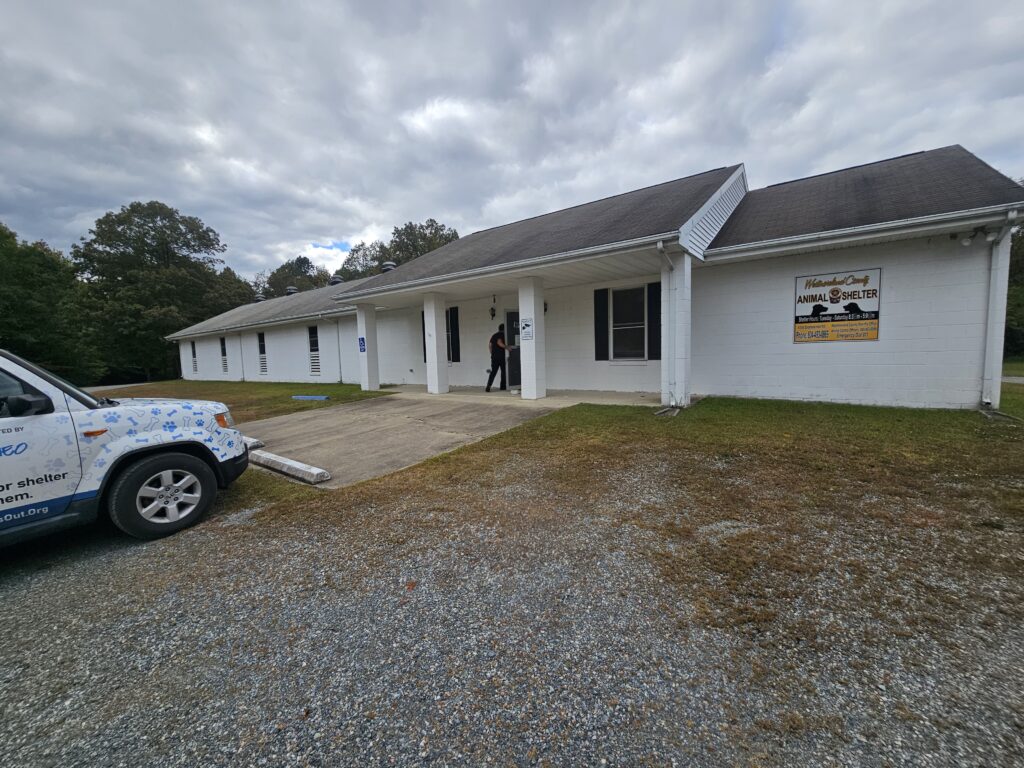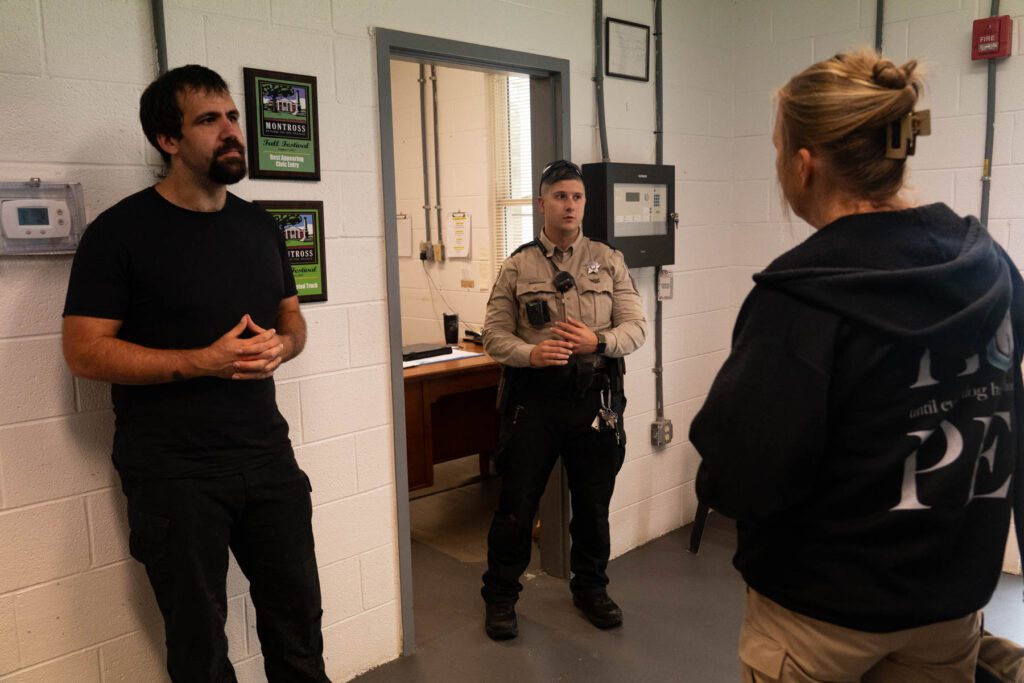Westmoreland County Animal Shelter sits at the end of a lane, past a young vineyard, just outside the town of Montross. It’s a large, well-kept cement building surrounded by grassy space. We met Deputy Kriz, one of the Animal Control Officers who runs the shelter, and Kieran, the kennel attendant who cares for the dogs.

Kieran has been at the shelter for three years. He’s a large, quiet man who had a gentle way with the dogs. His affection for them was clear in how he talked about and handled the dogs. I asked him what he liked about working at the shelter and he said he liked being a part of rehabilitating the dogs. Deputy Kriz, who has been at the shelter for four years, nodded in agreement.
Kieran said, “You get a dog who has only experienced pain from other people in his life and you see him learn to love and enjoy life.”
“That’s a good feeling,” Deputy Kriz said.

The shelter is an open intake facility with 26 kennels but only had 17 dogs on the day of our visit. In 2022 they handled nearly 300 dogs and euthanized 38. Deputy Kriz told me they only euthanize dogs with untreatable medical diagnoses or dogs deemed dangerous.
The shelter receives a lot of support from its community. The Art of Coffee, (where we had probably the best lunch we’ve ever had on tour and enjoyed their wifi to squeeze in a little work), does a food drive for them every November, and High Tides in Colonial Beach and the local high school have also collected and delivered donations.
The shelter vaccinates dogs on intake for distemper, and all the dogs are spayed/neutered thanks to the Animal Welfare League (whose name we have heard praised at each of the shelters we’ve visited on the Northern Neck). If the shelter is unable to have the dog spayed/neutered before it’s adopted, they send the adopter with a certificate and follow up to be sure they’ve followed through with their promise to spay/neuter within 30 days. They don’t heartworm test on intake, but if a dog presents with heartworm symptoms, they will have it tested and if positive, will treat it, usually with donated funds.




The shelter only has one regular volunteer at the moment but has had others apply. Because it is run by the Sheriff’s office, volunteers and potential fosters (which they also use) must go through a background check before they can volunteer. Deputy Kriz said they’ve had quite a few apply to volunteer lately and hopes some of them will actually come to the shelter to volunteer once they’ve been cleared. Too often, they don’t follow through.
We walked through the kennels quickly (I never want to stress the dogs out more than necessary and these dogs were pretty highly stressed) and I handed out lots of treats. Most of the dogs were more than friendly, and most were hound dogs or pit mixes. The shelter has one fenced play area outside, but with so few workers or volunteers, they don’t get outside a lot. Hounds and pit mixes are energetic dogs who need plenty of exercise and engagement, so hopefully some of those would-be volunteers will show up soon.




Nancy and I asked Kieran to bring out Ike, their longest resident, a skinny, sweet hound dog who has been at the shelter since April. I fed him every treat I had, and we left them with a bottle of Dyne in the hopes it would help put a little weight on his skinny frame.




We unloaded lots more treats and toys and a few necessities like pill pockets and squeeze-cheese. We always wish we could do more – but what this shelter, like every shelter we visit, needs most is more rescue connections and adopters. But volunteers could certainly make a difference in the mental well-being of the dogs.
All three of the shelters we visited in one day were just thirty minutes or less apart. It’s impressive that each of these counties has a tax-payer funded shelter and even more impressive that all enjoy a lot of community support that enables them to save most of their dogs. But they are all still rescue-dependent to save dogs. Thankfully, the commitment to spay/neuter is solid on the Northern Neck, so with time, their intake numbers may come down. More affordable pet-friendly housing would also go a long way towards keeping pets in their homes. For now, though, they are holding their own doing a lot with a little.
There is still time to order your copy of the 2024 Who Will Let the Dogs Out Calendar featuring the photography of Nancy Slattery and some of the amazing animals we’ve met on this year’s tours. To get your calendar (with free shipping!), click here.



Until each one has a home,
Cara
If you want to learn more, be sure to subscribe to this blog. And help us spread the word by sharing this post with others. Visit our website to learn more.
You can also help raise awareness by following/commenting/sharing us on Facebook, Instagram, YouTube, Tik Tok, and the Who Will Let the Dogs Out podcast.
To see our Emmy-nominated, award-winning short documentary, Amber’s Halfway Home, click here.

Learn more about what is happening in our southern shelters and rescues in the book, One Hundred Dogs & Counting: One Woman, Ten Thousand Miles, and a Journey Into the Heart of Shelters and Rescues (Pegasus Books, 2020). It’s the story of a challenging foster dog who inspired me to travel south to find out where all the dogs were coming from. It tells the story of how Who Will Let the Dogs Out began. Find it anywhere books are sold. A portion of the proceeds of every book sold go to help unwanted animals in the south.
For more information on any of our projects, to talk about rescue in your neck of the woods, or become a WWLDO volunteer, please email whowillletthedogsout@gmail.com or carasueachterberg@gmail.com.
And for links to everything WWLDO check out our Linktree.



Leave a Comment
Sign up for our newsletter
Sign up to have our latest news, grant updates, shelter visits, and more delivered to your inbox.
Share this:
Like this: